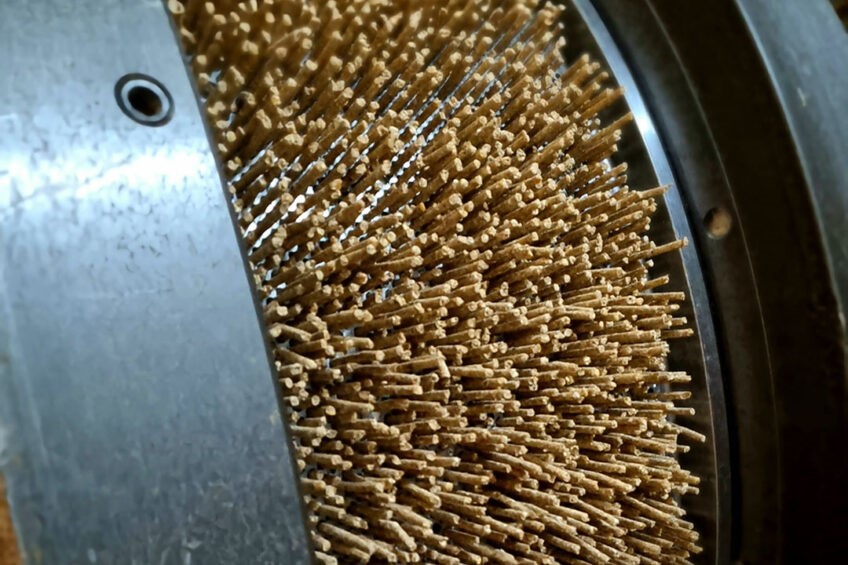The quality and durability of pelleted feeds are affected by the shape of the pellets, ingredient properties, and feed mill operations such as grinding, mixing, cooking, adding moisture and compacting. About 20% of the grain quality depends on grinding. For the pelletizing process, feed mill procedures and standards are also crucial.

Correct grinding
About 20% of the grain quality depends on grinding. Determining the correct particle size is the first essential step in feed production, as it greatly affects nutrient absorption. The grain size depends on the species to be fed – poultry feeds require a coarser grain size, while pig or sow feeds require a finer grain.
Fine grinding allows greater penetration of heat and moisture. Grinding ingredients into particles smaller than 300 microns improves the gelatinization process during conditioning and results in durable, high-quality granules. Coarse grinding increases the risk of brittle or broken pellets because the gelatinization process is not as efficient as heat and moisture cannot penetrate the particles as quickly as they should.
Grain size must be considered in tool specifications. For example, if someone uses a 4.0mm diameter tool, but uses a grinding screen with a larger diameter hole, they will end up re-grinding the feed using the pellet mill as a grinder. This negatively affects pellet mill performance and pellet quality. The need for regrinding should be avoided. The recipe must be verified and the equipment must be set properly for the specified particle size.
Why is mixing so important?
The mixer is the heart of the feed mill. The purpose of the grinding process may be to produce pellets that contain all the nutrients needed for animal consumption. If the mixing quality is not tested or controlled, it is almost impossible to achieve this parameter.
Two factors that affect the mixing quality of feed paste are the particle size of raw materials and the efficiency of the mixer, which is evaluated by the coefficient of variation (CV%). CV is the measure that verifies that a sample of feed taken at the mill or pellets consumed on the farm contains the required level of nutrients prepared by a nutritionist.
Key elements that influence mixing practice include the type of mixer used, its capacity and mixing time. The size of the item must be at the appropriate level. Longer mixing does not mean better mixing. The order in which the ingredients are added is also important. The mixing system should be evaluated, inspected and tested after each adjustment. For complete nutrition, a good CV is between 5-10%. Values higher than 10% indicate that improvements are needed, such as increasing the mixing time or adjusting the mixer.
Why is pellet durability so important?
Pellet durability (PDI) is a quality index that reflects how likely the feed is to reach the animal intact for consumption. Required PDI is higher than 90-95. Achieving this target value helps avoid wasting feed during transportation or when the feed is consumed on the farm.
Factors that affect PDI include feed composition, grain size, conditioning, quenching, general equipment conditions and tool pressure ratio, and feed composition. A high PDI helps the animal save energy that would otherwise be used to capture smaller particles. In addition, the nutritional value of the feed is improved, as fewer nutrients in the delicacy are lost due to breakage.
The condition of the tool and roller must be monitored. Plant managers typically look at the number of tons produced as an indicator of parts replacement. Checking the condition of the equipment can be a better indicator of when to replace.
Take advantage of moisture
Improving moisture content can help reduce shrinkage caused by moisture loss during storage, grinding and cooling. Adding controlled amounts of moisture at certain stages of the pellet production process can support quality, digestibility, and process efficiency.
For example, adding steam during conditioning can improve the texture of the pulp feed. Steam modifies the physical and chemical properties of the feed, provides a lubricating and binding effect, and increases the permeability of the feed. It also assists in the movement of feed through the pellet machine matrix, improving feed digestibility and reducing processing costs.
Moisture engineering additives such as Selko Fylax Forte-HC liquid can be used to enhance moisture penetration, retention and starch formation. These additives add moisture to the feed mass, ensuring that it reaches the conditioner with a moisture content of around 14-15%. Fylax Forte-HC liquid components withstand processing temperatures and remain active long after the feed has been produced, transported and stored.
Many decisions can affect the quality and durability of pelleted feed. With processes in mind, knowing the particle size requirements for each type and optimizing equipment settings can make achieving durable, high-quality pellets a simple exercise.
(source: allaboutfeed.net)












































